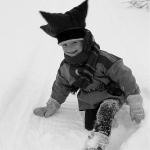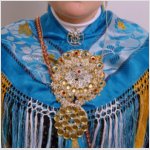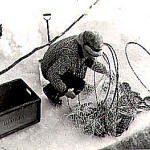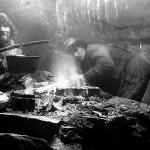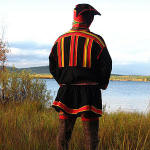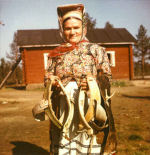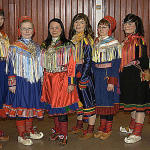

Home
Area
Vätsäri
Övre Pasvik
Pasvik Zapovednik
Nature
Geology
Climate
Water system
Flora
Fauna
Culture
Population
Religion
Sources of livelihood
Old ways of life
Time of industrialism
History
Stone Age
Early Metal Age
Late Metal Age
Middle Ages
Towards modern times
Timeline
Cooperation
Nature monitoring
Nature tourism
Publications
Contacts
Visit Pasvik-Inari
Guidelines
Regulations
News
Links
Population
Inari Sámi
Inari Sámi have lived in one state and within one municipality, surrounding of Lake Inari, throughout the historic era. Other Sámi groups and Finns have settled in the Inari region later on. According to historic and remembered information as well as place names, the original living area of Inari Sámi has been more extensive. For instance, there are Inari Sámi place names and traditions concerning Inari Sámi inhabitation of the River Inari on the Norwegian and Finnish border. Nowadays, many Inari Sámi live outside the traditional living area in Finland and abroad. It is hard to estimate the Inari Sámi population. According to the census statistics, there are around 1000 Inari Sámi, but only 300 of them speak the Inari Sámi language.
Skolt Sámi
The traditional living area of Skolt Sámi in the Kola Peninsula has extended from Neiden to Pechenga (Petsamo) and to Tuuloma Lapland. The setting of boundaries between the three empires has many times brought difficulties to the Sámi way of life. An enormous change for Skolt Sámi was caused after the World War II, when Finland lost the area of Pechenga. As a result, Skolt Sámi lost their native lands in Pechenga, and they were resettled in the villages of Sevettijärvi and Nellim with the help of the Finnish Government in 1949. In terms of their language and traditions, they belong to the Eastern Sámi, and they are Orthodox in religion.
It is estimated that there are around 700 Skolt Sámi in Finland today, but some 300 of them speak Skolt Sámi. Most Skolt Sámi live in the so-called Skolt Sámi area, which is situated in the eastern parts of the municipality of Inari and to the south, south-east and north-east of Lake Inari. In Russia, most of them have been colonised by the state to the area of Lovozero. In Norway, Skolt Sámi live around Neiden and Pasvik, but most of them are blended into the majority population.
Northern Sámi
Northern Sámi - also known as the reindeer or fell Sámi - have lived a nomadic life, migrating along with the reindeer herds. Reindeer economy spread to Lapland in the 17th century. The reindeer Sámi of Varanger area had their winter pastures in the surroundings of Lake Inari. In 1852, the closing of border between Norway and Finland caused dramatic changes to the migrating life. Since the 1860s, many reindeer Sámis moved to the Finnish side of the border with their herds and gradually multiplied the amount of reindeers in Utsjoki and Inari. As the ancient ways to the Arctic Sea coast were cut, the immigrants settled in the new areas around Lake Inari. Nowadays, there are around 30 000 speakers of the Northern Sámi language who live in Finland, Norway and Sweden.
Finns, Norwegians and Russians
Before the Middle Ages, the evasive Finnish, Norwegian and Russian tradesmen had vivid trade contacts with the Sámi population living in the area. At first, the tradesmen had also a right to collect taxes from Sámi people, but eventually taxation was totally organised by states of Sweden-Finland, Denmark-Norway and Russia. From the 17th century onwards, the laws and acts were made in each country to promote the spreading of peasant settlement northward. Gradually the border between the Sámi and other settlers vanished.
Kvens
The population of Inari area increased during the 18th century, but then the climate suddenly changed, crops failed, and famine and waves of diseases swept over the area. These incidents launched the immigration from Finland to the Norwegian Pasvik valley and Varangerfjord in the 1850s. Stories about huge catches of fish and about never-ending bread tempted people from Eastern Carelia, Kainuu, Ostrobothnia, Kittilä and Sodankylä. Norwegian authorities used the name kven for everyone who came from Finland, and even today this name is used by their descendants. In 1996, kvens were recognised as having minority status in Norway.
Impacts of legislation on population in the 1800-1900s
In the late 1800s, Norwegian authorities made initiatives to increase the Norwegian population in the Pasvik River valley because the area was almost dominated by Finnish immigrants. Many strategies were used: one of them was to invite people from southern Norway and encourage them to settle down and spread the Norwegian culture. Little by little, the Norwegian settlement gained foothold in the area; especially the nationwide settlement campaign of the 1920s succeeded.
A new statute to settle the Kola coast was given in 1868 in Russia. The law promised advantages for settlers, such as releasing from taxes and military service, loans for trade and acquiring of land and household. At first the settlers and the Skolt Sámi coexisted peacefully, but soon the old domains of Sámi were occupied by others.
The peace treaty of Tartto between the Soviet Union and Finland was signed in 1920, and Russia was obliged to surrender the Pechenga area to Finland. There were already many Finns living on the eastern side of the Pasvik River when the area belonged to Russia, but in the 1920s the vast settling and building of the area started. Contacts and trade along the river prospered until Finland lost Pechanga to Russia in the Second World War in 1944. Since then, the Pechenga area has belonged to Russia.
